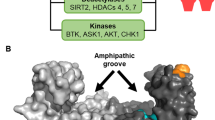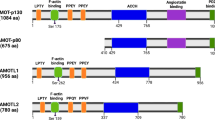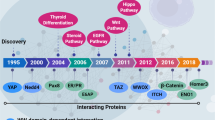Abstract
14-3-3 proteins are relevant to cancer biology as they are key regulators of major cellular processes such as proliferation, differentiation, senescence and apoptosis. So far, the sigma isoform (14-3-3σ) has most directly been implicated in carcinogenesis and was recognized as a tumour-suppressor gene. The other six members of the mammalian 14-3-3 gene family likely behave as oncogenes, although direct evidence supporting this view is largely circumstantial. In this report, we show that knockdown of 14-3-3ζ induces at least two isoform-specific phenotypes that are consistent with a potential oncogenic activity during tumorigenesis. Firstly, downregulation of 14-3-3ζ sensitized cells to stress-induced apoptosis and JNK/p38 signalling and secondly, it enforced cell–cell contacts and expression of adhesion proteins. Apparently, the zeta isoform restrains both cell adhesion and the cellular propensity for apoptosis, two activities that are also restrained during carcinogenesis. The assumption that 14-3-3ζ has oncogenic properties was substantiated with a web-based meta-analysis (Oncomine), revealing that 14-3-3ζ is overexpressed in various types of carcinomas. As the highly conserved human 14-3-3 gene family encodes proteins with either tumour-promoting or tumour-suppressing activities, we infer that the cellular balance between the various 14-3-3 isoforms is crucial for the proper functioning of cells.
This is a preview of subscription content, access via your institution
Access options
Subscribe to this journal
Receive 50 print issues and online access
$259.00 per year
only $5.18 per issue
Buy this article
- Purchase on Springer Link
- Instant access to full article PDF
Prices may be subject to local taxes which are calculated during checkout




Similar content being viewed by others
References
Arora S, Matta A, Shukla NK, Deo SV, Ralhan R . (2005). Identification of differentially expressed genes in oral squamous cell carcinoma. Mol Carcinog 42: 97–108.
Balda MS, Matter K . (2003). Epithelial cell adhesion and the regulation of gene expression. Trends Cell Biol 13: 310–318.
Beavon IR . (2000). The E-cadherin–catenin complex in tumour metastasis: structure, function and regulation. Eur J Cancer 36: 1607–1620.
Boukamp P, Petrussevska RT, Breitkreutz D, Hornung J, Markham A, Fusenig NE . (1988). Normal keratinization in a spontaneously immortalized aneuploid human keratinocyte cell line. J Cell Biol 106: 761–771.
Brummelkamp TR, Bernards R, Agami R . (2002). A system for stable expression of short interfering RNAs in mammalian cells. Science 296: 550–553.
Buckley PG, Mantripragada KK, Benetkiewicz M, Tapia-Paez I, Diaz De Stahl T, Rosenquist M et al. (2002). A full-coverage, high-resolution human chromosome 22 genomic microarray for clinical and research applications. Hum Mol Genet 11: 3221–3229.
Burnworth B, Popp S, Stark HJ, Steinkraus V, Brocker EB, Hartschuh W et al. (2006). Gain of 11q/cyclin D1 overexpression is an essential early step in skin cancer development and causes abnormal tissue organization and differentiation. Oncogene 25: 4399–4412.
Clairotte A, Lascombe I, Fauconnet S, Mauny F, Felix S, Algros MP et al. (2006). Expression of E-cadherin and alpha-, beta-, gamma-catenins in patients with bladder cancer: identification of gamma-catenin as a new prognostic marker of neoplastic progression in T1 superficial urothelial tumors. Am J Clin Pathol 125: 119–126.
Dent P, Yacoub A, Fisher PB, Hagan MP, Grant S . (2003). MAPK pathways in radiation responses. Oncogene 22: 5885–5896.
Ghadimi BM, Grade M, Liersch T, Langer C, Siemer A, Fuzesi L et al. (2003). Gain of chromosome 8q23-24 is a predictive marker for lymph node positivity in colorectal cancer. Clin Cancer Res 9: 1808–1814.
Hanahan D, Weinberg RA . (2000). The hallmarks of cancer. Cell 100: 57–70.
Hekman M, Albert S, Galmiche A, Rennefahrt UE, Fueller J, Fischer A et al. (2006). Reversible membrane interaction of BAD requires two C-terminal lipid binding domains in conjunction with 14-3-3 protein binding. J Biol Chem 281: 17321–17336.
Hermeking H . (2003). The 14-3-3 cancer connection. Nat Rev Cancer 3: 931–943.
Hermeking H, Lengauer C, Polyak K, He TC, Zhang L, Thiagalingam S et al. (1997). 14-3-3 sigma is a p53-regulated inhibitor of G2/M progression. Mol Cell 1: 3–11.
Jang JS, Cho HY, Lee YJ, Ha WS, Kim HW . (2004). The differential proteome profile of stomach cancer: identification of the biomarker candidates. Oncol Res 14: 491–499.
Jin Y, Dai MS, Lu SZ, Xu Y, Luo Z, Zhao Y et al. (2006). 14-3-3gamma binds to MDMX that is phosphorylated by UV-activated Chk1, resulting in p53 activation. EMBO J 25: 1207–1218.
Kim BJ, Ryu SW, Song BJ . (2006). JNK- and p38 kinase-mediated phosphorylation of Bax leads to its activation and mitochondrial translocation and to apoptosis of human hepatoma HepG2 cells. J Biol Chem 281: 21256–21265.
Niemantsverdriet M, Jongmans W, Backendorf C . (2005). Radiation response and cell cycle regulation of p53 rescued malignant keratinocytes. Exp Cell Res 310: 237–247.
Porter GW, Khuri FR, Fu H . (2006). Dynamic 14-3-3/client protein interactions integrate survival and apoptotic pathways. Semin Cancer Biol 16: 193–202.
Rhodes DR, Chinnaiyan AM . (2005). Integrative analysis of the cancer transcriptome. Nat Genet 37 (Suppl): S31–S37.
Rhodes DR, Yu J, Shanker K, Deshpande N, Varambally R, Ghosh D et al. (2004). ONCOMINE: a cancer microarray database and integrated data-mining platform. Neoplasia 6: 1–6.
Sugiyama A, Miyagi Y, Komiya Y, Kurabe N, Kitanaka C, Kato N et al. (2003). Forced expression of antisense 14-3-3beta RNA suppresses tumor cell growth in vitro and in vivo. Carcinogenesis 24: 1549–1559.
Tada K, Oka M, Tangoku A, Hayashi H, Oga A, Sasaki K . (2000). Gains of 8q23-qter and 20q and loss of 11q22-qter in esophageal squamous cell carcinoma associated with lymph node metastasis. Cancer 88: 268–273.
Takeuchi T, Liang SB, Ohtsuki Y . (2002). Downregulation of expression of a novel cadherin molecule, T-cadherin, in basal cell carcinoma of the skin. Mol Carcinog 35: 173–179.
Takihara Y, Matsuda Y, Hara J . (2000). Role of the beta isoform of 14-3-3 proteins in cellular proliferation and oncogenic transformation. Carcinogenesis 21: 2073–2077.
Tzivion G, Gupta VS, Kaplun L, Balan V . (2006). 14-3-3 proteins as potential oncogenes. Semin Cancer Biol 16: 203–213.
Ueda G, Sunakawa H, Nakamori K, Shinya T, Tsuhako W, Tamura Y et al. (2006). Aberrant expression of beta- and gamma-catenin is an independent prognostic marker in oral squamous cell carcinoma. Int J Oral Maxillofac Surg 35: 356–361.
van Hemert MJ, Steensma HY, van Heusden GP . (2001). 14-3-3 proteins: key regulators of cell division, signalling and apoptosis. BioEssays 23: 936–946.
Wang B, Liu K, Lin FT, Lin WC . (2004). A role for 14-3-3 tau in E2F1 stabilization and DNA damage-induced apoptosis. J Biol Chem 279: 54140–54152.
Wanzel M, Kleine-Kohlbrecher D, Herold S, Hock A, Berns K, Park J et al. (2005). Akt and 14-3-3eta regulate Miz1 to control cell-cycle arrest after DNA damage. Nat Cell Biol 7: 30–41.
Zang L, Palmer Toy D, Hancock WS, Sgroi DC, Karger BL . (2004). Proteomic analysis of ductal carcinoma of the breast using laser capture microdissection, LC-MS, and 16O/18O isotopic labeling. J Proteome Res 3: 604–612.
Acknowledgements
The authors thank Dr H van Dam (Leiden) for the p-JNK and the p-p38 antibodies, Kim Janssen and Mohammed Hamdi for technical assistance, Dr N Fusenig (Heidelberg) for HaCaT cells and Dr R Agami (Amsterdam) for the pSuper plasmid. Drs A Visser, M Noteborn and J Brouwer (Leiden) are acknowledged for critically reading this paper.
Author information
Authors and Affiliations
Corresponding author
Additional information
Supplementary Information accompanies the paper on the Oncogene website (http://www.nature.com/onc).
Supplementary information
Rights and permissions
About this article
Cite this article
Niemantsverdriet, M., Wagner, K., Visser, M. et al. Cellular functions of 14-3-3ζ in apoptosis and cell adhesion emphasize its oncogenic character. Oncogene 27, 1315–1319 (2008). https://doi.org/10.1038/sj.onc.1210742
Received:
Revised:
Accepted:
Published:
Issue Date:
DOI: https://doi.org/10.1038/sj.onc.1210742



